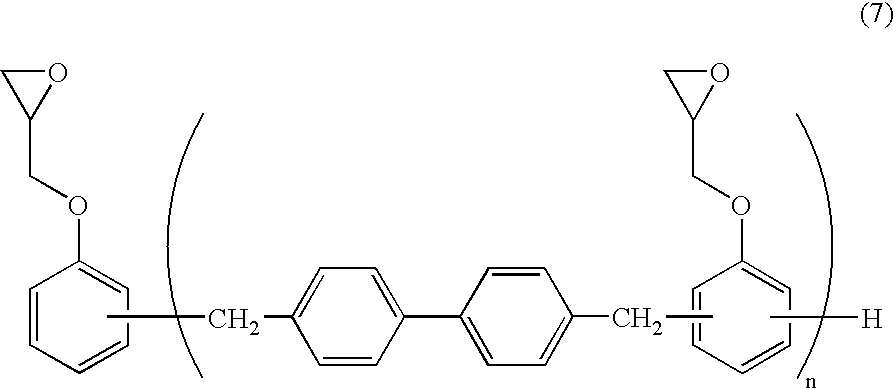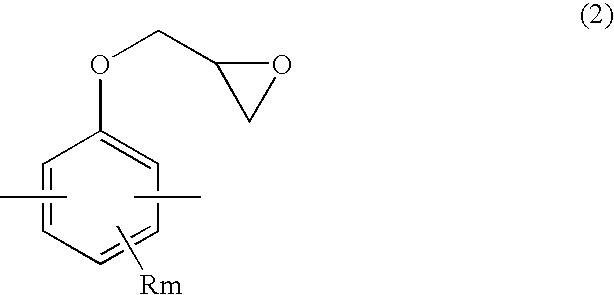Epoxy Resin, Hardenable Resin Composition Containing the Same and Use Thereof
a technology of epoxy resin and hardenable resin, which is applied in the field of epoxy resin with high molecular weight and its use, can solve the problems of low molecular weight compounds that are likely to precipitate as crystals and the solubility of solvents tends to worsen, so as to improve the workability and improve the properties
- Summary
- Abstract
- Description
- Claims
- Application Information
AI Technical Summary
Benefits of technology
Problems solved by technology
Method used
Image
Examples
example 1
[0102]100 parts of a phenol-biphenyl novolak type epoxy resin (manufactured by Nippon Kayaku Co., Ltd., trade name: NC-3000-H, epoxy equivalent: 288 g / eq, softening point: 68° C., ortho bond:para bond (molar ratio)=60:40 to 55:45) and 50 parts of methyl isobutyl ketone were added to a flask provided with a stirring machine, a reflux cooling tube, and a stirring apparatus, and dissolved sufficiently at 100° C. After cooling to 60° C., 200 parts of methanol was added, and the obtained suspension was stirred under reflux for one hour, and then allowed to stand at 50° C. for 30 minutes to confirm two-layer separation. The upper layer part of the two layers separated was extracted by decantation, and 25 parts of methyl isobutyl ketone and 200 parts of methanol were further added to the residue, and stirred again under reflux for one hour. After this, standing at 50° C. for 30 minutes was performed to confirm two-layer separation. The upper layer part of the two layers separated was separ...
example 2
[0104]100 parts of a phenol-biphenyl novolak type epoxy resin (manufactured by Nippon Kayaku Co., Ltd., trade name: NC-3000, epoxy equivalent: 274 g / eq, softening point: 54° C.) and 50 parts of methyl isobutyl ketone were added to a flask provided with a stirring machine, a reflux cooling tube, and a stirring apparatus, and dissolved sufficiently at 100° C. After cooling to 60° C., 200 parts of methanol was added, and the obtained suspension was stirred under reflux for one hour, and then allowed to stand at 50° C. for 30 minutes to confirm two-layer separation. The upper layer part of the two layers separated was extracted by decantation, and 25 parts of methyl isobutyl ketone and 200 parts of methanol were further added to the residue, and stirred again under reflux for one hour. After this, standing at 50° C. for 30 minutes was performed to confirm two-layer separation. The upper layer part of the two layers separated was separated by decantation. This standing and separation ope...
example 3
[0106]Operations similar to those in Example 1 were performed using a flask provided with a stirring machine, a reflux cooling tube, and a stirring apparatus, and 100 parts of (phenol, β-naphthol)-biphenyl novolak type epoxy resin (manufactured by the method described in Japanese Patent No. 3575776, naphthol / (phenol+naphthol)=0.34, epoxy equivalent: 284 g / eq, softening point: 69° C.) to obtain 81 parts of the target epoxy resin (EP3). The obtained EP3 had an epoxy equivalent of 299 g / eq, a softening point of 83° C., and a bifunctional compound area % of 18%.
PUM
| Property | Measurement | Unit |
|---|---|---|
| Fraction | aaaaa | aaaaa |
| Softening point | aaaaa | aaaaa |
| Softening point | aaaaa | aaaaa |
Abstract
Description
Claims
Application Information
 Login to View More
Login to View More - R&D
- Intellectual Property
- Life Sciences
- Materials
- Tech Scout
- Unparalleled Data Quality
- Higher Quality Content
- 60% Fewer Hallucinations
Browse by: Latest US Patents, China's latest patents, Technical Efficacy Thesaurus, Application Domain, Technology Topic, Popular Technical Reports.
© 2025 PatSnap. All rights reserved.Legal|Privacy policy|Modern Slavery Act Transparency Statement|Sitemap|About US| Contact US: help@patsnap.com



